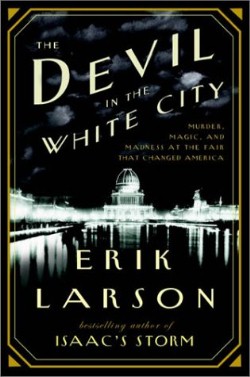Title: The Devil in the White City: Murder, Magic, and Madness at the Fair that Changed America.
Author: Erik Larson
Pages: 464 (paperback)
Published: February 10th 2004
Published by: Knopf Doubleday Publishing Group
Author Erik Larson imbues the incredible events surrounding the 1893 Chicago World's Fair with such drama that readers may find themselves checking the book's categorization to be sure that 'The Devil in the White City' is not, in fact, a highly imaginative novel. Larson tells the stories of two men: Daniel H. Burnham, the architect responsible for the fair's construction, and H.H. Holmes, a serial killer masquerading as a charming doctor. Burnham's challenge was immense. In a short period of time, he was forced to overcome the death of his partner and numerous other obstacles to construct the famous "White City" around which the fair was built. His efforts to complete the project, and the fair's incredible success, are skillfully related along with entertaining appearances by such notables as Buffalo Bill Cody, Susan B. Anthony, and Thomas Edison. The activities of the sinister Dr. Holmes, who is believed to be responsible for scores of murders around the time of the fair, are equally remarkable. He devised and erected the World's Fair Hotel, complete with crematorium and gas chamber, near the fairgrounds and used the event as well as his own charismatic personality to lure victims. Combining the stories of an architect and a killer in one book, mostly in alternating chapters, seems like an odd choice but it works. The magical appeal and horrifying dark side of 19th-century Chicago are both revealed through Larson's skillful writing.
Daniel Burnham and H. H. Holmes are two men who took advantage of Chicago winning the prestigious rights to hold a World's Fair. One was an architect who was determined that the event would beat the Paris Exposition a number of years before and who pushed himself and everyone around him to achieve this. The other was a serial killer who took advantage of the many people who visited the fair alone, using his charm and charisma as a mask to his psychopathy and as a way to slake his thirst for death. Two very different men, but their stories are interwoven into this book.
I don't read many non-fiction books, and I when I do they tend to be more psychology-based. While one could argue that the whole 'psychopath serial killer' thing is rather psychological, this isn't really the focus. Given that much of what it is thought Holmes did is based on speculation rather than fact you never really get inside his head at all. In spite of this being somewhat outside my normal reading I really enjoyed this book. Larson has obviously done his research - and done it very well - but also manages to put it on the page in a way that is both informative, interesting and (most importantly) engaging. While still not exactly a book I could sit and read for hours at a time, I could quite happily sit and read a number of chapters in a go.
This is achieved in part because of the interweaving of stories throughout, all essential to the fair and the events which transpired. Burnham and Holmes are the main focus, but there are other people who were equally important which get their share of the page-time. A couple were quite random and you didn't really see how they'd have any impact until they did. But there were also just stories of the fair from regular people who had no impact on the larger picture. Couples meeting at the fair and small follow-ups to their lives, what people thought of various things and those who would later became famous (various future Presidents cropped up, and Mark Twain went to Chicago but never made it to the fair) or were related to famous names (Walt Disney's father worked there). The narrative does a great job of showing just how much of an impact this fair had on America and it's people.
While there isn't any mystery to Holmes' true nature it is interesting seeing how he interacts with people and how his psychopathy evolves over time. He is an incredibly charming and disarming man, and there are many accounts of him defusing difficult situations, be they financial or when someone comes looking for missing people, with the greatest of ease. Without a doubt inventive, he is something of a criminal master-mind and very adept at hiding his killing, to the point where no one can really even guess as to how many victims he had.
Burnham and the building of the fair is interesting in a whole different way as you see the fight he had to become an architect, to win the necessary people over to the cause, and then navigate all the bureaucracy to achieve the vision he had of this magnificent event. He fights incredibly hard all the way and refuses to give up on what he wants, which is true of a number of other people involved in the build. The other that stands out is a young engineer who had an idea to top that of the Eiffel Tower (the centre-piece of the Paris Exposition) who had to fight to have others believe it was something that was achievable...but I won't spoil who he was or what he built for those, like me, who don't already know.
I went into this knowing absolutely nothing about the World's Fair in Chicago, and have come out wishing I was alive to see it thanks to the picture painted here. It sounds amazing, and this book does both it and the darkness in Holmes justice. Well worth a read.


There is one building from the World's Fair still standing. Chicago turned it into a museum.
ReplyDeleteAwesome! If I ever make it across to America I shall add that to my list of things to see.
Delete